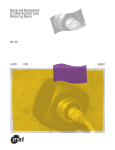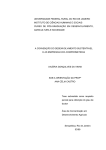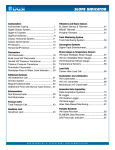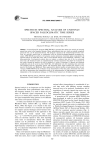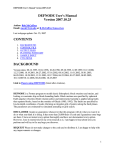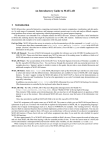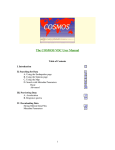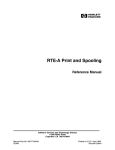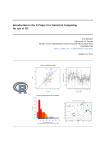Download Estimating tides in strainmeter data ( ( )2 ( )2
Transcript
1 Estimating tides in strainmeter data Introduction At time periods of days to months earth tides dominate the signal in strain and tiltmeter data. In fact the earth tides provide a known strain signal with which to perform an in-situ calibration of the instruments. However, to identify transients in strain data the tidal signal must be removed and the relation between external forces and strain change identified. Consider Figure 1 which shows the strain changes recorded by 5 volumetric dilatometers in Parkfield at the time of the M6.0 28 September 2004, Parkfield earthquake. We see the tides clearly and we see an apparent change in strain rate that preceded the earthquake by ~7 days. We can also see however, that the strain changes are temporally correlated with the atmospheric pressure. Performing a tidal analysis of strain or tilt data is therefore necessary for two reasons; the amplitudes and phases of the main tidal constituents can be used to calibrate the instrument and, once known, the tidal parameters can be used to predict the tides at any time and the tidal signal may be removed from the data. To remove the tides we need to identify the phase and amplitude of the main tidal constituents in the time series. There are a variety of free software packages that estimate the tides in time series data. • PIASD. Package for Interactive Analysis of Strain Data (Agnew May 2004). • T-tide. A Matlab program that performs classical harmonic analysis for periods shorter than one year (Pawlowicz, R., Beardsley, B., and Lentz, S., 2002). • TSOFT. A windows based tidal analysis package (Van Camp, M., and Vauterin, P. 2005) • ETERNA. Uses the least squares method to estimate tidal parameters, meteorological and hydrological responses (Wenzel, 1996). Runs on an MS-DOS system. • BAYTAP-G. A package that implements Bayesian statistics to estimate tidal parameters and meteorological responses (Tamura et al., 1991). It is written in FORTRAN77 and runs on most UNIX like systems. BAYATP-G is widely used in the scientific community and it is the package we will use in this course. BAYTAP-G In the lecture on earth tides we saw that the tides can be thought of as a series of bands, or groups separated by one cycle/month. BAYTAP-G assumes that within one group the phase and amplitude of the individual tides are constant and it is these two terms that we solve for within each group. With an increasing number of data points we can resolve more groups of tides and determine a more accurate description of the tidal signal. BAYTAP-G assumes that a signal yi can be decomposed into a tidal signal ti, a trend term di, perturbation term ri and a random noise term ei, (1) y i = t i + d i + ri + e i The perturbation term, or response term, is the change in the signal induced by another force such as atmospheric pressure. Tidal parameters, the trend, response terms and noise are estimated through an iterative method similar to least square adjustment by minimizing equation (2) for a data set of length n, 2 K n " M % 2 2 y A C +B S -d b x -hz + ( ) ! $ i ! m mi m mi i ! k i-k i ' D ! [ d i -2d i-1 +d i-2 ] & i=1 # m=1 k=0 i=1 n M 2 2 + WEIGHT ! "( A m -A m-1 ) + ( Bm -Bm-1 ) % # & m=2 2 (2) 2 2 Donnalee Microstrain 1.5 Vineyard Frolich 1 Jack Canyon 0.5 Red Hills 2004/9/16 2004/9/18 2004/9/20 2004/9/22 2004/9/24 2004/9/26 2004/9/28 165 ATM Pressure (mbars) Atmospheric pressure 160 155 150 145 2004/9/16 2004/9/18 2004/9/20 2004/9/22 2004/9/24 2004/9/26 2004/9/28 2004/9/30 Figure 1. Strain change measured by volumetric dilatometers in Parkfield September 2004. where M is a group number of tidal constituents, Cmi and Smi are the summation of the cosine and sine parts of each of the constituents in the m-th group respectively (theoretical values), Am and Bm are the tidal constants to be determined, di is the trend, xi are associated data, bk are response weights, h is step value and zi is a step function whose value is zero until a step occurs and increases by one after a step. D and WEIGHT are hyperparameters that are chosen to minimize ABIC. BAYTAP-G assumes that the trend varies smoothly and is represented by di = 2di-1 - di-2 + ui (3) 3 where di is the trend at observation point i and di-1 and di-2 are the trend values at the two preceding data points. The term ui represents a white noise component. The program varies D and each time computes the Akaike Bayesian Information Criterion (ABIC) value. The best set of tidal parameters, trend values and response coefficients are found when the ABIC value is minimized. The user can control how many iterations are stepped through and place constraints on minimum values of D. The program will stop when the minimum ABIC is reached. The following notes illustrate how to use BAYTAP-G to estimate the phase and amplitudes of the main tidal constituents in strain or tidal data. These constituents can be to generate a time series correction to remove the tidal signal from the dataset. They can also be used to calibrate the instrument by comparing the observed phase and amplitude with that predicted by theory. We will work through two examples: 1. We will estimate the tides in data from a Gladwin tensor strainmeter and form a set of amplitudes and phases of the M2 and O1 tides as measured by each gage. 2. We will estimate the tidal parameters for the M2 and O1 tides as measured by a volumetric dilatometer and also estimate the atmospheric pressure response. Installing and running BAYTAP-G BAYTAP-G is written in FORTRAN77. It is available as a tar file from the National Astronomical Observatory, Mizusawa, Japan via anonymous ftp. The recommended reference is (Tamura et al., 1991). Since the program does not produce any graphics it is easily installed and compiled using f77 or g77. The BAYTAP-G manual explains all possible processing options and data formats. The following examples however, summarize the most important options for strain data analysis. BAYTAP-G requires two input files; a file that contains the processing options, the input05.dat file, and a tidal data set, in this case strain. Associated data sets e.g. atmospheric or pore pressure are optional input files. Everything input to the program is read in formatted statements. This means that you have to be careful that the input files are formatted correctly. In both the examples below we will use the user-defined format (type 1 in the user’s manual). The strain data should be cleaned before input to BAYTAP-G. By cleaning we mean obvious outliers, steps and periods of noisy data are removed regardless of whether the irregular data are geophysical or instrumental in origin. It is also important to remove any steps or outliers in associated data sets if they are going to be used. Estimation of the phase and amplitudes of the earth tides for a 3-component tensor strainmeter. For this example we will look at the 3 component strain data measured by the Gladwin Tensor Strainmeter at Pinyon Flat Observatory (PFO) in Southern California. A laser strainmeter and three volumetric dilatometers have also been installed at PFO and so the data set proves an interesting one in terms of comparing the measured earth tides with that measured by a co-located laser strainmeter and dilatometers and with theoretical models. The instrument was installed in December 1983 and samples at 18 minute intervals. The data set consists of 3 months of data measured in 1990 (figure 2). The data have had borehole trends removed and have been lowpass filtered and decimated to 3-hour sample intervals. The sample data sets are in the data directory, /home/data/baytap_examples and are called input05.dat.pft, input12.dat.pft1, input12.dat.pft2 and input12.dat.pft3. 4 150 100 50 COUNTS 0 -50 -100 -150 -200 gage1 gage2 gage3 -250 1990/Jan/1 1990/Feb/1 1990/Mar/1 1990/Apr/1 Date Figure 2. Three months of data from Pinyon Flat GTSM. The data are edited and have had the borehole trends removed. Parameter Input File. The input05.dat file defines the period of data being analyzed and contains all the parameter settings used by the program. All processing parameters must be placed between &PARAM and &END. Example of input05.dat file. Line 1 &PARAM 2 KIND=7, 3 SPAN=1780 , 4 SHIFT=1780, 5 DMIN=1, 6 LPOUT=0, 7 FILOUT=1, 8 TIMSYS=0.0D0, 9 MAXITR = 21, 10 &END 5 11 12 13 14 15 16 17 18 19 20 1990 1 1 8.45 2170 3.0 0 GROUPING ( 0:AUTO; -2,-1,1--6:MANUAL ) 12 1 0 I/O UNIT, FORMAT, STEP ( TIDAL DATASET ) 9999 TITLE STRAIN TIDE ANALYSIS 9999 PINYON FLAT CALIFORNIA STATION NAME GLADWIN TENSOR STRAINMETER INSTRUMENT NAME 9999 COUNTS UNIT OF TIDAL DATA KIND. Defines the kind of theoretical tide calculation for analysis. 1. Gravity tide, micro-Gal, increase is taken to be positive. 2. NS Tilt, millisecond of arc. Subsiding northern ground taken to be positive. For a horizontal pendulum tiltmeter, tending the pendulum to the north is positive and for a water tube tiltmeter, uplift of water level in the northern pot is positive. For water tube tiltmeters, the data set must be the difference of water levels between the northern and southern pots. 3. EW Tilt, millisecond of arc. Subsiding eastern ground is taken to be positive. There is an optional parameter AZ that allows analysis of the tilt tide in any direction. If the direction of tilt is n degrees measured clockwise from north, set KIND=2 and AZ=n. 4. NS Strain. 5. EW Strain. 6. NE Strain. 7. Strain. The tide generating potential / mean earth radius / acceleration due to gravity is used as the theoretical tide where the mean radius is assumed to be 6371023.6 m. This value is non-dimensional. 8. Ocean tide, cm, uplift is taken to be positive. The theoretical value is defined as potential / mean gravity where mean gravity is 982.024 Gals. SPAN. The number of observations to process in one window. SHIFT. The number of data points the data window being analyzed is shifted by. For example, if SPAN=744 and SHIFT=720, the data window will be 744 observations long and overlap by 24 data points. If SHIFT is set to zero the trend is not obtained and BAYTAP-G processes with the entire data set ignoring the SPAN parameter. If the SHIFT is greater than the SPAN the data that are skipped are not used in the analysis. DMIN. The lower limit of hyperparameter D. BAYTAP-G searches for the value of D that minimizes the ABIC value. The range searched for the D value is DMIN=<D =<1000.0. The default value is 0.25. LPOUT. Tidal analysis output. If LPOUT=0 the estimated tidal factors and the frequency response of associated data are printed. If LPOUT=1 and SHIFT>0, the determined trend and irregular part are also printed. If LPOUT=2 then debug information is printed along with the output of LPOUT=1. The default value is 0. FILOUT. Tidal calculations output. BAYTAP-G assumes the input data can be decomposed into four parts: the tidal component, trend, response part (if an associated dataset exists) and irregular part (noise). The result of this decomposition is written to an output16.dat file when FILOUT=1. TIMSYS. Correction amount by which to adjust time system to UTC. For example, if the data are observed in UTC, TIMSYS=0.0. If the time system is Japanese Standard Time (JST), TIMSYS = -9.0. The difference between ephemeris time (dynamic time) and universal time is fixed to 51 seconds. MAXITR. Upper limit of number of iterations to search minimum ABIC. The default value is 21. 6 The input data are described on lines 11 to 20 of the above example. 11. Beginning date of analysis, number of samples and resample interval. The FORMAT is as follows, YYYY MM DD NNNN S.S (3I5,F5.0,I5,F10.0). where YYYY is the year, MM the month and DD the day of the month. NNNN is the number of samples and S.S is the sample interval in hours. If the files are type 1 (user defined format type) the sample interval given here is ignored and the value is defined in the tidal data set (input12.dat file). 12. Grouping of tidal constituents. The number of tidal constituents to be determined by the program is set here. If this parameter is zero, the number of groups is automatically selected according to the data length as follows. Data window (days) Number of groups 0 to 8 3 8 to 16 5 16 to 180 12 180 to 364 14 364 to 2000 15 > 2000 20 Groups can also be defined manually. If the grouping parameter is set to -2, -1, 1, 2, 3, 4, 5 or 6 then 3, 5, 12, 14, 15, 20, 22 and 31 groups are adopted respectively no matter what the data length is. However, it is advisable to select the number of groups considering the quality and amount of data. 13. Tidal data set. The input unit number for the tidal dataset, format specification, and flag to re-estimate a step size respectively are specified on this line. The unit number corresponds to the input file name of the tidal data set. For example, 12 would imply the filename of the tidal dataset is input12.dat. The format type describes the format of the data; it is one of -1, 0 or 1. 14-16. Title line. This will be printed in the output files. Descriptive text can be recorded within the next 10 lines. It must be preceded and followed by the term 9999. 17. Station name 18. Instrument name 20. Unit of tidal data. Since one of the main reasons we look at the amplitude and phases of the tides is for calibration purposes we input the data in volts, or counts, as measured by the data logger. Then we can relate the amplitude and phase of the tide in counts to that predicted in nanostrain. 7 Tidal Data Input file We specified on line 12 of the input05.dat file that the strain data file would be called input12.dat. We also specified that the data would be input in a user-defined format. We will define what the format will be in the input12.dat file. The following is an example of an input12.dat file. Line 1 2 3 4 5 6 7 8 1. 2. 3. 4. 5. 6. Content PINYON FLAT OBSERVATORY, GTSM, GAUGE 1 33.610 -116.4550 0.00 982.024 1990 1 1 8.45 2170 3.0 99990.0 (6F12.4) 4565.000 44566.000 44567.000 44568.000 44565.000 44566.000 4565.000 44563.000 99999.000 44561.000 44563.000 44564.000 ….. Title Coordinates of site. Latitude and longitude (degrees), altitude (m), acceleration due to gravity (cm/s2). Date of first observation. The format is YYYY MM DD HH.HH where YYYY is the year, MM is the month, DD is the day of the month and HH.HH is the hour. Number of observations, sampling interval (units of hours), missing data flag. The missing data flag must be positive or zero. If it is positive, data whose absolute values are greater than the missing data flag are ignored. If it is zero, all observations are used in the analysis. Format of input data. Describes the format of the data in a FORTRAN77 formatting statement, e.g., 6f12.4 would imply six values per row each twelve characters long with four decimal places. Input data. The tidal analysis output file The following is a description of the results from BAYTAP-G after analyzing the data from gage 3 of the Pinyon Flat tensor strainmeter. The tidal results are output to file output06.dat. In our example lines 1 to 71 list all the parameter settings, data start date, and station information. You should check these values to make sure that your input files are formatted correctly. Note that all the parameter settings are listed. If we did not specifically set them then the default values are used where necessary. Line 74 contains the date and time of the first and last data points of each window. This is another opportunity to check the time interval, dates and number of sample has been read in correctly. The ABIC trace information follows. BAYTAP-G varies the parameter D to try and attain a minimum value for the ABIC value. The program starts with a D value that is four times DMIN and iterates until it reaches a minimum. If the minimum value is not reached and BAYTAP reaches the DMIN value then a warning message is generated and the program continues using the DMIN value in the input05.dat file. In this example we set DMIN to be 0.5, the program therefore begins with a D value of 4.0 78 ABIC(4.0000E+00)=132.95 ALSQE=-5.87259E+02 ALNDN=1.28587E+03 ALNDTD= 9.27765E+02 79ABIC(5.6569E+00)=197.58 ALSQE=-4.44761E+02 ALNDN=1.48399E+03 ALNDTD=1.16482E+03 80 ABIC(2.8284E+00)= 88.02 ALSQE=-7.25021E+02 ALNDN=1.09523E+03 ALNDTD=6.90709E+02 81 ABIC(2.0000E+00)= 59.18 ALSQE=-8.64761E+02 ALNDN=9.13621E+02 ALNDTD=4.53652E+02 82 ABIC(1.4142E+00)= 45.02 ALSQE=-1.01195E+03 ALNDN=7.43084E+02 ALNDTD=2.16596E+02 83 ABIC(1.0000E+00)=46.77 ALSQE=-1.17073E+03 ALNDN=5.86288E+02 ALNDTD=-2.04605E+01 84 85 MINIMUM ABIC= 45.02 ATTAINED AT VMIN = 1.4142E+00 SD = 4.7724E-01 8 The program iterates six times before finding that a DMIN of 1.4142 gives the best ABIC value of 45.02. There is some trial and error here in choosing an initial DMIN value and making sure that you have set the number of iterations, MAXITR, large enough. The station information, data window information and tidal values are printed between lines 105 and 136. For each tidal group the print out shows the tidal group name, a tidal factor and error, the phase with respect to the local potential and error and the amplitude and error. The amplitude is in the same units as the input. 105 106 107 108 109 110 111 112 113 114 115 116 117 118 119 120 121 122 123 124 125 126 127 128 129 130 131 132 133 134 135 136 STATION Pinyon Flat LON.= -116.455 E LAT.= 33.610 N H = 0.00 M INSTRUMENT GTSM AMPLITUDE COUNTS PERIOD 1990 1 3 8.8 - 1990 3 29 17.8 AVAILABLE / BLOCK LEN. 684 / 684 ANALYZED BY BAYTAP-G VERSION 99-11-15 POTENTIAL : TAMURA, Y., 1987, BIM, 99. (WITH P4) CALCULATION : NATIONAL ASTRONOMICAL OBSERVATORY, MIZUSAWA GROUP 1 2 3 4 5 6 SYMBOL ( 1-143 : Q1) (144-201 : O1) (202-249 : M1) (250-305 : P1S1K1) (306-345 : J1) (346-450 : OO1) 7 (451-549 : 2N2) 8 (550-599 : N2) 9 (600-655 : M2) 10 (656-681 : L2) 11 (682-827 : S2K2) 12 (828-909 : M3 FACTOR (RMSE) PHASE (RMSE) AMPLITUDE (RMSE) (LOCAL, LAG:NEGATIVE) 0.57317 ( 0.01601) -19.688 ( 1.603) 1.597 ( 0.045 ) 0.58692 ( 0.00267) -16.203 ( 0.261) 8.542 ( 0.039 ) 0.61817 ( 0.03463) -19.629 ( 3.209) 0.708 ( 0.040 ) 0.54246 ( 0.00188) -14.220 ( 0.199) 11.104 ( 0.039 ) 0.62440 ( 0.03325) 3.852 ( 3.051) 0.715 ( 0.038 ) 0.68638 ( 0.03416) -10.333 ( 2.850) 0.430 ( 0.021 ) 0.85911 ( 0.04293) 25.371 ( 2.869) 0.578 ( 0.029 ) 0.74344 ( 0.00625) 7.941 ( 0.481) 3.782 ( 0.032 ) 0.63454 ( 0.00107) 6.027 ( 0.097) 16.860 ( 0.028 ) 0.75694 ( 0.04889) -13.121 ( 3.696) 0.568 ( 0.037 ) 0.59756 ( 0.00186) -7.220 ( 0.179) 7.387 ( 0.023 ) ) 0.21205 ( 0.08853) 38.428 ( 23.930) 0.061 ( 0.026 ) Since the data set is 3 months long and we instructed the program to automatically select the number of tidal groups 12 groups are solved for. The M2 and O1 tides are those usually used to calibrate strainmeters, as they are the largest tides with periods sufficiently different from 24 hours so as not to be contaminated by thermal or other diurnal non-tidal signals. The phase of the M2 tide is 6.027±0.097 degrees and the amplitude is 16.860±0.028 counts. The factor column contain the relative amplitudes that would be input to Tamura’s tidal prediction program BAYTAP-G also prints out a useful plot of the power spectrum of the trend. We expect that if the tides have been properly estimated then there will be no energy above the background noise at the tidal frequencies. This plot provides a quick visual guide as to how well the tides have been determined. 9 Time series output file. If FILOUT=1 was specified in the input05.dat file then an output16.dat will be written. The output is decomposed into four parts; the tidal component, the trend, the response (if there is associated data) and a noise part, ORIGINAL DATA = TIDAL COMP + TREND + RESPONSE + NOISE. In this example the response part is zero, as we have no associated data. Plot_baytap.sh is a simple GMT script that can be used to plot the data. It reads the results from the output16.dat file and the start times and titles from the input12.dat file. The process of estimating the amplitude and phase of the M2 and O1 tides is repeated for each gauge. The final results are a set of 12 observations, the phase and amplitude of the M2 and O1 tides for three gauges. The results from this analysis are summarized in Table 1. Table 1. Phase (degrees) and amplitude (counts) of the M2 and O1 tides on each of the PFO tensor strainmeter. M2 phase M2 amp O1 phase O1 amp Gage1 69.633 ( 0.440) 5.209 ( 0.040 ) 8.464 ( 0.889) 8.045 ( 0.125 ) Gage2 -1.443 ( 0.258) 26.449 ( 0.119 ) 14.189 ( 3.432) 5.754 ( 0.345 ) Gage3 6.027 ( 0.095) 16.860 ( 0.028 ) -16.203 ( 0.270) 8.542 ( 0.040 ) When we use these parameters for calibration it is often more useful if they are described as real and imaginary numbers rather than the amplitudes and phases. If a signal is expressed in terms of amplitude R, and phase theta then the real component is computed using R*cos(theta) and the imaginary component computed using R*sin(theta). Estimating the relation between atmospheric pressure and strain change BAYTAP-G can be used to estimate the linear relation between strain change and changes in pressure. In this example we will look at how to estimate a linear relation between atmospheric pressure and volumetric strainmeters using BAYTAP-G. Volumetric dilatometers consist of fluid-filled chambers that are several feet long and thus are much more sensitive to changes in vertical strain than Gladwin Tensor Strainmeters where each cell is ~17 cm tall. As for the above example we should begin with a cleaned strain and pressure data set. We will look at the strain data from the volumetric dilatometer at Donna Lee from August to October 2004. The data have been cleaned, low pass filtered and decimated to 1-hour samples using the methods outlined in Viewing and Editing data. The data are then reformatted into BAYTAP-G files. The BAYATAP-G files for Donnalee are in /home/data/baytap_example and called input05.dat.donnalee, input12.dat.donnalee and input14.dat.donnalee. Parameter Input File. The input05.dat file is similar to the above example. This time we include information on an associated data set, in this case atmospheric pressure. 1 2 3 4 5 6 7 &PARAM KIND=7, SPAN=2171, SHIFT=2171, DMIN=0.01, LPOUT=0, FILOUT=1, 10 8 9 10 11 12 13 14 15 16 17 18 19 20 21 22 23 24 IAUG=1, LAGP=0, TIMSYS=0.0D0 MAXITR = 50, &END 2004 08 1 19.0 2171 1.0 0 GROUPING ( 0:AUTO; -2,-1,1--6:MANUAL ) 12 1 0 I/O UNIT, FORMAT, STEP ( TIDAL DATASET ) 14 1 0 I/O UNIT, FORMAT, STEP ( ATM DATASET ) 9999 TITLE VOLUMETRIC STRAIN 9999 DONNALEE PARKFIELD STATION NAME SINGLE CHAMBER VOL DILATOMETER INSTRUMENT NAME 9999 COUNTS UNIT OF TIDAL DATA ATMOSPHERIC PRESSURE TITLE OF ASSOSIATED DATASET We have set the shift and span to the same value which means the data will be analyzed in one window. The IAUG states there is one associated data set (atmospheric pressure). LAGP sets the allowable time lag between pressure change and strain change to be zero hours. A response coefficient will be calculated for each allowable lag; if we allow a lag of up to 3 hours BAYTAP-G will calculate the response coefficient at 0, 1, 2 and 3 hours. The input file has 2171 observation points and the time series begins on 19:00, 1 August, 2004 UTC (line 13). We specify that the associated data will be in unit 14 (line 16). The units of the tidal data set and title of the atmospheric pressure data are stated on lines 23 and 24 respectively. The strain input file (input12.dat) and the pressure input file (input14.dat) have exactly the same data formats as described in first example. The strain data is in units of counts and the pressure data in units of millibars. The header lines of the input12.dat and input14.dat files have similar information, 1 2 3 4 5 DONNALEE PARKFIELD VOL DILATOMETER 35.94 -120.42 568.0 980.122 2004 8 1 19.0 2171 1.0 99990.D0 (1F9.1,4F13.1) On line 4 the missing data flag is set to 999990.0, any data point with a value greater than this will not be used in the analysis. The output files. An output06.dat and an output16.dat file are created. Looking at the ouput06.dat file we should check that the dates and correct number of samples have been read correctly. The following line numbers correspond to the numbers of the lines in the output06.dat file. 48 49 50 51 52 DATE OF THE FIRST DATA YEAR MONTH DAY 2004 8 1 HOUR DATA COUNT SAMPLING 19.00 2171 1.00 *** SPAN = 2171 *** SHIFT = 2171 The program stepped through the minimizing algorithm six times. Our initial value of DMIN is set to 0.05 in the input05.dat file so the program begins with a D value of 0.2. It reached a minimum value at D= 7.0711E-02 and an ABIC value of 3736.17. 11 89 ABIC(2.0000E-1)= 3741.65 ALSQE=-3.75324E+3 ALNDN=2.30894E+2 ALNDTD=-3.51455E+03 90 ABIC(2.8284E-1)= 3757.68 ALSQE=-2.56940E+3 ALNDN=3.99404E+2 ALNDTD=-2.76214E+03 91 ABIC(1.4142E-1)= 3738.07 ALSQE=-5.04583E+3 ALNDN=1.22986E+2 ALNDTD=-4.26696E+03 92 ABIC(1.0000E-1)= 3736.94 ALSQE=-6.42014E+3 ALNDN=5.71691E+1 ALNDTD=-5.01937E+03 93 ABIC(7.0711E-2)= 3736.17 ALSQE=-7.84571E+3 ALNDN=1.71553E+1 ALNDTD= -5.77178E+03 94 ABIC(5.0000E-2)= 3737.14 ALSQE=-9.29865E+3 ALNDN=-8.30084E+0 ALNDTD=-6.52420E+03 95 96 MINIMUM ABIC = 3736.17 ATTAINED AT VMIN = 7.0711E-02 SD = 1.6197E-01 This output06.dat file contains information on the pressure response coefficient. 106 RESPONSE WEIGHTS ASSOCIATED DATASET NO. = 1 107 LAG = 0 108 RESPC = 2.57748E+01 109 ERROR = 2.24831E-01 This means that at zero lag interval one millibar of pressure change induces a change of 2.57748E+01±2.24831E-01 counts of strain. The phase and amplitudes of the tidal groups and the associated uncertainty follow. 137 138 139 140 141 142 143 144 145 146 147 148 149 150 151 152 GROUP 1 2 3 4 5 6 SYMBOL ( 1-143 : Q1) (144-201 : O1) (202-249 : M1) (250-305 : P1S1K1) (306-345 : J1) (346-450 : OO1) 7 (451-549 : 2N2) 8 (550-599 : N2) 9 (600-655 : M2) 10 (656-681 : L2) 11 (682-827 : S2K2) FACTOR (RMSE) PHASE (RMSE) AMPLITUDE (RMSE) (LOCAL, LAG:NEGATIVE) 1.43024 ( 0.16271) 171.591 ( 6.519) 4.118 ( 0.468 ) 1.40260 ( 0.06474) 171.581 ( 2.646) 21.093 ( 0.974 ) 1.23411 ( 0.12193) 169.672 ( 5.660) 1.460 ( 0.144 ) 1.05665 ( 0.05042) 166.463 ( 2.720) 22.348 ( 1.066 ) 1.10994 ( 0.16200) 167.842 ( 8.360) 1.313 ( 0.192 ) 1.12289 ( 0.22124) 169.405 ( 11.289) 0.727 ( 0.143 ) 1.40348 ( 0.16807) 1.42390 ( 0.06628) 1.57712 ( 0.01138) 1.60321 ( 0.10609) 1.57998 ( 0.01844) -161.674 ( -160.402 ( -163.686 ( -169.593 ( -171.276 ( 12 (828-909 : M3) 0.63920 ( 0.46740) -176.189 ( 41.911) 6.861) 2.666) 0.414) 3.792) 0.738) 0.895 ( 0.107 ) 6.862 ( 0.319 ) 39.696 ( 0.286 ) 1.141 ( 0.075 ) 18.502 ( 0.216 ) 0.171 ( 0.125 ) The frequency response of the associated data, the power spectrum of the trend and a summary of potential outliers follow. Most of the data points listed in the summary correspond to missing data points where the trend or response could not be evaluated. We can examine the results by plotting the file output16.dat using plot_baytap_dates.sh (figure 3) . There is a small step in the trend on the 30 August. This offset corresponds to an instrument reset and an offset correction that was applied during editing. A small step still remains in the data set but is only visible once the tides have been removed. For this reason the editing process is often an iterative one where one edits the data and estimates the tides. The raw data should be re-edited with the tides removed. Once removed better offset corrections are achieved and other smaller offsets may become more easily identified. We can examine the effect of increasing the lag time for which we allow an atmospheric pressure response by running BAYTAP-G several times, each time increasing the LAGP value (Table 2). Each time we examine the ABIC value to look for an improvement in fit. 12 LAGP 0 ABIC 3736.17 1 3609.77 2 3603.08 3 3598.50 RESP0 2.5775E+01 ±2.248E-01 2.5416E+01 ±2.203E-01 2.5727E+01 ±2.3874E-01 2.5763E+01 ±2.3837E-01 RESP1 RESP2 RESP3 -2.5734E+00 ±2.2039E-01 -2.41325E+00 ±2.24581E-01 -2.73869E+00 ±2.42023E-01 8.12720E-01 ±2.39591E-01 6.63186E-01 ±2.42658E-01 -8.52815E-01 ±2.39259E-01 Letting the lag interval be up to 3 hours (LAGP=3) gives the lowest ABIC value indicating that allowing a 3-hour lag response gives a better fit to the data. Increasing LAGP to 4 results in a larger ABIC value. The response coefficient is largest at zero lag and becomes less significant as the lag increases. The phase and amplitude of the M2 and O1 tides are not changed outside the RMS error listed in the output. The response coefficients, although above the stated error are two orders of magnitude less than the response coefficients at zero and 1-hour lags. Figure 4 shows the original data minus the tides and the pressure response from the output16.dat file from the 16th to the 30th September, 2004. You can see that while the shorter-term variations in strain caused by the pressure changes are removed from the data there is still a change in trend from the 20 to 22 of September that may be correlated with pressure changes. Estimating the pressure response using crossspectral analysis is another way to try and remove this longer-term pressure signal. 13 DONNALEE PARKFIELD VOL DILATOMETER 7000 ORIGINAL 6500 6000 8 15 22 29 5 August 50 12 19 26 3 10 September 17 24 October TIDE 0 -50 -100 8 15 22 29 5 August 12 19 26 3 10 September 17 24 October 200 100 RESPONSE 0 -100 -200 -300 8 15 22 29 5 August 7000 12 19 26 3 10 September 17 24 October TREND 6500 6000 8 15 22 29 5 August 5 4 3 2 1 0 -1 -2 -3 -4 -5 12 19 26 3 10 September 17 24 October IRREGULAR 8 15 August 22 29 5 12 19 September 26 3 10 17 24 October Figure 3.Jul Three months of data from1Donnalee Parkfield. Atm lag is zero. Figure X. Output from BAYTAP-G, August tovolumetric 1 October,dilatometer, 2004. Lag interval is zero. 2005 3 14:09:09 14 9000 ORIGINAL COUNTS 8500 8000 ORIGINAL - TIDES 7500 ORIGINAL - TIDES - ATM PRESSURE RESP 7000 2004/9/16 2004/9/18 2004/9/20 2004/9/22 2004/9/24 2004/9/26 2004/9/28 2004/9/30 2004/9/22 2004/9/24 2004/9/26 2004/9/28 2004/9/30 165 ATM Pressure (mbars) Atmospheric pressure 160 155 150 145 2004/9/16 2004/9/18 2004/9/20 Figure 4. Strain data from Donnalee with tides and atmospheric pressure response removed. The atm response lag is three hours. The lower figure shows the atmospheric pressure measured at Donnalee. Once the amplitude and phase of the M2 and O1 tides are known a time series correction can be generated using those parameters for any time period and sample interval using the program hartid from the SPOTL package (Agnew, 1996). Although BAYTAP-G solves for at least 12 tidal groups it is best to input just the M2, O1 and N2 parameters if the analysis is based on 3 to 6 months of data. If the data set is longer than 6 months then the K1 tide could be included. The program then uses spline interpolation to estimate the amplitudes of an additional 116 individual tides; 18 long- period, 51 diurnal, and 50 semidiurnal constituents are used in the prediction. 15 In theory if the tidal amplitudes and phases have been found for one window of data then they should not change over the lifetime of the instrument. A set of M2 and O1 parameters determined from three months of data should be sufficient to predict the tides at a time many years later. For laser strainmeters this is the case but it has been found that for some dilatometers and GTSMs the tidal parameters are not constant with time. Figure 5 shows the change in M2 amplitude at the Coyote dilatometer in the Bay Area. The entire data set from the instrument was analyzed in 2-month windows using BAYTAP-G and the amplitude and phases plotted. There is a clear drift in M2 amplitude with time; the reason may be a result of aging cables or electronic drift. The implication is that the scale factors at this site will change with time. Figure 6 shows that change in phase of the M2 tide as measured by the PFO GTSM. While the phases for gages 2 and 3 remain constant with time the gage 1 M2 phase changes by ~12° again, the implication is that the scale factor will change with time. 16 Figure 5. Amplitude and phase of the M2 tide at the Coyote Hills volumetric dilatometer, Bay area. 17 Pinyon Flat GTSM 5 0 Degrees -5 -10 M2 Phase -15 G1_phase_change G3_phase_change G2_phase_change -20 1984 1988 1992 1996 2000 2004 Year Figure 6. Change in M2 phase with time at the PFO GTSM. References Agnew, D.C., 1996: SPOTL: Some Programs for Ocean-Tide Loading, SIO Reference Series 96-8, p.34. Pawlowicz, R., Beardsley, B., and Lentz, S., 2002. Classical tidal harmonic analysis including error estimates in MATLAB using T_TIDE. Computers and Geosciences, 28(8): 929-937. Van Camp, M., and Vauterin, P., Tsoft: graphical and interactive software for the analysis of time series and Earth tides, Computers & Geosciences, 31(5) 631-640, 2005. Wenzel, H. G. 1996, The nanogal software; Earth tide data processing package ETERNA 3.30, Marees Terrestres. Bulletin d'Informations, 124 (1996): 9425-9439. 18 Tamura, Y., T.Sato, M.Ooe and M.Ishiguro, 1991: A Procedure for Tidal Analysis with a Bayesian Information Criterion, Geophysical Journal International, 104, 507-516.





















